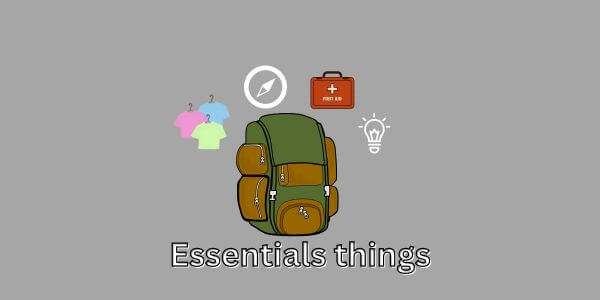The backpack weight while camping is a common and dependable travel companion that goes with you on all of your travels, whether it involves a quick commute to work, a weekend hiking excursion, or an international vacation. The condition of your bag, however, might frequently mirror the disarray of a tangled web. A daily annoyance might be rummaging through an unorganized bag in search of your keys, wallet, or other item. But don’t worry! We’ll examine practical strategies for managing your bag so that it functions as an orderly sanctuary of ease.
Organization of your backpack opens the door to a lifestyle that is less stressful and more productive. Consider the amount of time you’ve wasted searching through your backpack to find anything crucial. An organized bag may help you save time and anxiety during the day.
The Benefits of an Efficiently Managed Backpack
- Time-Saving: Having quick access to your things means spending less time digging through a messy bag.
- Stress Reduction: Knowing where everything is in a neat backpack helps peace of mind.
- Improved Safety: Having basics organized might be a lifeline in an emergency.
- Goods Preservation: Protect fragile goods from harm caused by jostling and disarray.
- Improved Posture: Properly distributed weight can lessen pressure on your back.

Choosing the Right Backpack for Your Needs
Choosing the correct backpack is the first step in effective backpack management. It is critical to select a backpack that meets your individual needs. Here are some things to think about:
- Size: Select a size that corresponds to your intended application. A smaller daypack is ideal for short travels, whilst a bigger one may be required for longer trips or outdoor pursuits.
- Features: Look for features like several compartments, padded laptop sleeves, water bottle pockets, and adjustable straps that are appropriate for your lifestyle.
- Durability: Quality matters in terms of durability. A well-made, durable backpack may endure for years, saving you money on repeated replacements.
- Comfort: Make sure the backpack is easy to wear by including cushioned shoulder straps and back support.
Important Items to Carry in Your Backpack
What you bring in your backpack is primarily determined by your needs, although the following items are universally useful:
- Water bottle: It is critical to stay hydrated, and a reusable water bottle is both eco-friendly and cost-effective.
- Notebook and pen: A notebook and pen are always useful for writing down ideas, taking notes, or drawing a quick sketch.
- Snacks: Keep some non-perishable snacks on hand, such as granola bars, in case you need an energy boost.
- Umbrella: You never know when the weather will change unexpectedly.
- Spare Change and Tiny Bills: These are useful for emergencies and little expenditures.
Examining the Function of Your Backpack
Consider the primary objective of your bag before you begin filling it. Do you intend to use it for travel, business, education, or outdoor activities? Understanding this will assist you in better organizing it.
- Travel: If you’re going anywhere, consider what you’ll need. Long travels can be made more pleasant with travel papers, travel-sized toiletries, and entertainment alternatives such as a book or iPad.
- Work: You may require a laptop, charging cords, and work-related papers or tools.
- School: For assignments, students should consider textbooks, notebooks, stationery, and maybe a laptop.
- Outdoor activities: Outdoor enthusiasts should have equipment such as a first-aid kit, maps, a torch, and other necessities for their individual excursions.

Grouping Items by Category
Efficient organization is the foundation of backpack management. Categorize and categorize your products in a way that makes sense to you. Examples of common categories include:
- Electronics: Place your laptop, tablet, portable panels, and chargers in the same location. To avoid tangling, use cable organizers.
- Stationery: Keep pens, pencils, and your notepad in a separate pocket or pouch.
- Clothing: To save space and keep your clothes together, fold or roll them.
- Toiletries: Keep your toiletries in a sealed pouch to keep leaks from contaminating other products.
- Snacks: Keep them in a different container or pocket to prevent crumbs from getting into your devices or clothes.
Packing Cubes and Organizers
Packing cubes and organizers are like magic tools for keeping your backpack organized. They help you to organize your possessions by compartmentalizing them.
Consider utilizing different-sized packing cubes for clothing, electronics, and toiletries. These cubes are straightforward to pack and unpack, making it easy to find what you’re looking for. Invest in bags and organizers for minor stuff. Cables, chargers, pencils, and other tiny things may be stored in them without getting buried in the depths of your bag.
Getting Rid of Unnecessary Items
Getting rid of stuff you don’t need is one of the simplest methods to make your bag more manageable. Maintaining the effectiveness of your bag requires regular decluttering. Consider if each thing serves a function and whether you’ve recently utilized it. If not, perhaps it’s time to leave it at home.
Consider following the “one-in, one-out” rule: for every new item you put in your bag, take one out. This keeps your backpack slim and efficient.
Use of Pockets and Compartments
Most backpacks have several pockets and sections, and making the greatest use of them may improve your bag organization dramatically. Assign different functions to each pocket. As an example:
- Main compartment: Keep heavier stuff like books, clothing, or your laptop in this area.
- Front Pockets: Keep small items like your wallet, keys, and munchies in this pocket.
- Side Pockets: Keep your water bottle or umbrella in the side pockets for convenient access.
- Hidden Pockets: These are ideal for storing valuables or important papers.
Small Pouches for Small Things
Little pouches or ziplock bags are excellent for managing little objects that can easily become disorganized in your backpack weight while camping.
- Cable Pouch: Keep all of your cords, chargers, and earbuds together in one bag. This avoids knots and allows for quick access.
- Toiletry Pouch: Store your toiletries in a waterproof pouch to keep spills from contaminating your other belongings.
- Pen case: A separate pouch for pens and pencils keeps them from becoming disorganized in your luggage.

Avoid Stuffing Exterior Pockets
While using your backpack’s outer pockets for fast access is crucial, avoid overflowing them. If you put too much weight in these compartments, your backpack will become imbalanced and difficult to carry. Use them just for goods that you use regularly, such as your phone, keys, and snacks.
Common Backpack Pocket Assignments
| Pocket/Compartment | Suggested Use |
|---|---|
| Main Compartment | Laptop, books, clothing |
| Front Pocket | Wallet, keys, snacks |
| Side Pockets | Water bottle, umbrella |
| Hidden Pockets | Passport, valuables, documents |
Quick Packing and Unpacking Techniques
Packing efficiently is vital for easy access and a compact bag. Here are some helpful hints for preparing your backpack:
- Roll Your Clothing Instead of Folding Them: Rolling your garments saves space and prevents wrinkles.
- Use Packing Cubes: Packing cubes can help you organize your items and make packing and unpacking easier.
- Place Heavier Items Close to Your Back: Place heavier objects close to your back to provide even weight distribution and to avoid strain.
- Keep Frequently Used Items on Top: Items that you need to access frequently, such as your phone or wallet, should be immediately accessible.
Methods for Easy Access to Frequently Used Items
Quick access to goods you use regularly is also important for efficient backpack weight while camping organization. Here are some ideas for quick access:
- External Pockets: Use the external pockets of your backpack to store goods such as your phone, keys, or food.
- Organize by Priority: Keep the goods you use the most frequently at the top of the main compartment for easy access.
- Use Clear or Mesh Pockets: Clear or mesh pockets allow you to see the contents without having to rummage through the pocket.
Technology and Digital Organization
Technology may play an important part in backpack weight while camping organization in the digital era. Here’s how it’s done:
- Digital Documents: Instead of carrying hard copies of papers, scan and securely save them on your devices or in the cloud.
- Note-taking Software: Use programs like Evernote or OneNote to organize and retrieve your notes from any device.
- Navigation apps: GPS and map applications can be used to replace cumbersome printed maps and guidebooks.
Important Documents in Digital Form
Carrying physical copies of important papers, such as your passport or driver’s license, might be inconvenient. Make a digital copy, password-protect it, and store it in a secure cloud service or on a safe USB stick. This guarantees that you can still access these papers if your physical copies are lost or stolen.
Cables and Backup Power Sources
If you rely on electronic gadgets, keep backup power sources on hand, such as portable chargers or power banks. When you’re on the road and don’t have access to electrical outlets, these can be lifesavers. To avoid tangling, keep your cables organized in a designated bag.
Emergency and First Aid
Your bag should also contain emergency supplies. While you hope you never have to use them, being prepared is essential. Consider the following emergency items:
- First Aid Kit: A small kit containing bandages, antiseptic wipes, pain medications, and other essentials.
- Emergency Blanket: These little, lightweight blankets can keep you warm in an emergency.
- Flashlight: A compact, bright flashlight might come in handy during power outages or while exploring dark locations.
First Aid Kit and Its Contents
A basic first aid kit is an essential addition to your backpack. It should include:
- Bandages of various sizes
- Antiseptic wipes
- Adhesive tape
- Tweezers
- Scissors
- Pain relievers (e.g., ibuprofen)
- Antihistamines (for allergies)
- Disposable gloves
- First aid manual
Emergency Contact Information
Carry a list of emergency contact numbers and addresses with you at all times. Include contact information for local emergency agencies, the nearest embassy or consulate if going overseas, and the contact information for your next of kin. Having this knowledge readily available in an emergency can be lifesaving.
Common Items and Their Ideal Backpack Compartments
| Item | Ideal Compartment |
|---|---|
| Laptop or Tablet | Main Compartment |
| Wallet and Keys | Front Pocket |
| Water Bottle | Side Pocket or Holder |
| Pen and Stationery | Dedicated Pouch or Pocket |
| Spare Clothing | Packing Cube in Main Compartment |
| Toiletries | Toiletry Pouch in Main Compartment |
| Snacks | Front or Small Exterior Pocket |
| First Aid Kit | Main Compartment or External Pocket |
| Emergency Blanket | Main Compartment or Side Pocket |
| Flashlight | External Pocket or Dedicated Pouch |
Conclusion
Backpack weight while camping management is a skill that may make traveling easier and more fun. Whether you’re an experienced traveler, a busy student, or an urban worker, the suggestions and tactics given in this article will help you maintain your bag organized and tailored to your specific needs. These easy strategies to manage your bag can save you time, energy, and possible irritation, from selecting the correct backpack to filling it effectively and keeping a minimalist attitude.
In today’s fast-paced world, a well-managed backpack weight while camping may be your trusted companion, providing not only convenience but also peace of mind. So, put these tips into action, and watch your backpack transform into a dependable and effective partner in your everyday trips.
You May Also Like

